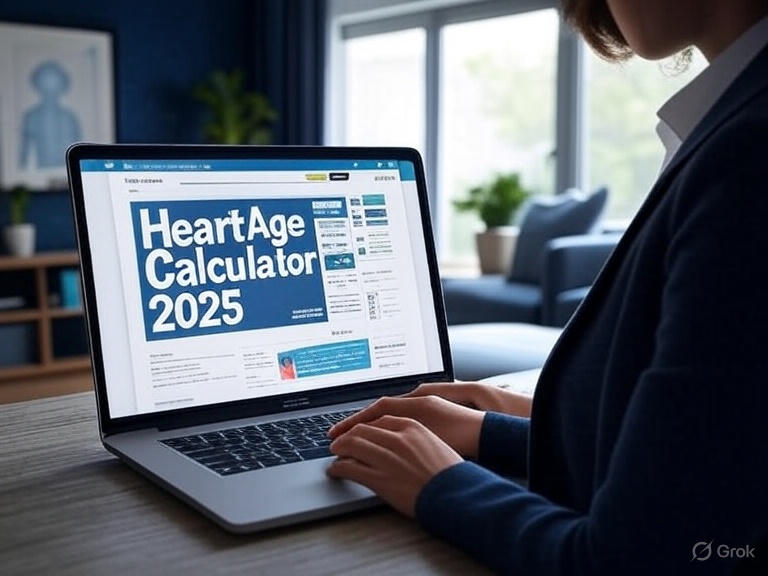Heart Age Calculator 2025: Is Your Heart Older Than You?

Your heart might be aging faster than you are, silently raising your risk of heart disease without you knowing. A groundbreaking heart age calculator 2025, launched by Northwestern University researchers and published in JAMA Cardiology on July 30, 2025, offers a free, user-friendly way to uncover your heart’s biological age, per The Washington Post. By answering simple questions about blood pressure, cholesterol, and other health metrics, you can learn whether your heart is older, younger, or in sync with your chronological age—and what that means for your cardiovascular health. With heart disease remaining the leading cause of death in the U.S., claiming 695,000 lives in 2023, per CDC, this tool is a wake-up call for Americans to take charge of their heart health. How does it work, and what can you do if your heart is aging too fast?
The Heart Age Calculator: How It Works
Developed by Sadiya Khan and her team at Northwestern University’s Feinberg School of Medicine, the heart age calculator translates the 2023 PREVENT (Predicting Risk of Cardiovascular Disease Events) equations into an intuitive tool, per The Washington Post. Available free online at heartage.northwestern.edu, it assesses your heart’s biological age for ages 30–79. Key features include:
- Input Metrics: Users enter blood pressure, cholesterol levels (total and HDL), blood sugar, smoking status, body mass index (BMI), and estimated glomerular filtration rate (eGFR) for kidney function. Optional inputs include C-reactive protein and hemoglobin A1c, per JAMA Cardiology.
- Output: The calculator estimates your heart’s biological age and 10-year/30-year risk of heart attack or stroke, comparing it to your chronological age. For example, a 40-year-old with high blood pressure might have a heart age of 50, signaling elevated risk, per The Washington Post.
- Data Basis: Built on PREVENT equations from 1.2 million U.S. adults, it uses benchmarks for optimal heart health by age and sex, validated against 14,000+ participants in the National Health and Nutrition Examination Survey (NHANES), per The Washington Post.
Khan’s study found that 60% of Americans aged 30–79 have hearts biologically older than their actual age, with men averaging a 7-year gap and women a 5-year gap, per JAMA Cardiology. This aligns with CDC data showing 50% of adults have at least one major cardiovascular risk factor, per CDC.
Why Heart Age Matters
Unlike chronological age, which counts years since birth, biological heart age reflects the wear and tear on your cardiovascular system from factors like hypertension, high cholesterol, or smoking, per The Washington Post. Key findings:
- Risk Indicator: A heart age 5+ years older than your chronological age signals heightened risk of heart attack or stroke, with a 10-year risk potentially doubling for each 5-year gap, per JAMA Cardiology.
- Public Health Crisis: The NHANES analysis revealed that even 30-somethings often have older hearts, with 25% of men aged 30–39 showing a 10+ year heart age gap, driven by untreated hypertension and obesity, per The Washington Post.
- Actionable Insights: Khan emphasizes that knowing your heart age can motivate lifestyle changes or medical interventions, as 50% of Americans with high blood pressure are untreated, and 60% eligible for statins aren’t prescribed them, per The Washington Post.
Critical Perspective: Strengths and Limitations
The establishment narrative, as presented by Khan and The Washington Post, touts the calculator as a revolutionary tool for public health, making complex risk data accessible. However, experts highlight gaps:
- Missing Factors: Martha Gulati of Cedars-Sinai notes the calculator omits women-specific risks like menopausal changes or pregnancy complications (e.g., preeclampsia), which increase heart disease risk by 20–30%, per American Heart Association. This limits its precision for women, who represent 51% of heart disease deaths, per CDC.
- Exercise Omission: Ulrik Wisloff, a Norwegian researcher, criticizes the exclusion of aerobic fitness and physical activity, which reduce heart disease risk by up to 40%, per European Heart Journal. His group’s fitnessagecalculator.no incorporates exercise, offering a complementary approach, per The Washington Post.
- Accessibility Barriers: While free, the calculator requires recent bloodwork (e.g., cholesterol, eGFR), which 30% of Americans lack due to healthcare access issues, per Kaiser Family Foundation. This may exclude low-income users.
- Gimmick or Game-Changer?: Gulati calls the tool “a bit gimmicky” but supports its motivational potential, per The Washington Post. Critics argue it oversimplifies complex risks, potentially causing anxiety without clear follow-up steps, per Healthline.
The narrative’s optimism overlooks these limitations, but the calculator’s simplicity makes it a valuable starting point for awareness, especially in a nation where only 12% of adults meet heart-healthy lifestyle criteria, per American Heart Association.
How to Use the Calculator and Act on Results
- Access the Tool: Visit heartage.northwestern.edu and input your health metrics. Schedule a doctor’s visit for blood pressure, cholesterol, and eGFR tests if needed, per JAMA Cardiology.
- Interpret Results: If your heart age is 5+ years older than your chronological age, consult a doctor. A 10-year risk above 7.5% may warrant statins or blood pressure medication, per American College of Cardiology.
- Lifestyle Changes:
- Exercise: Aim for 150 minutes of moderate aerobic activity weekly (e.g., brisk walking), which cuts heart disease risk by 25%, per CDC. Strength training twice weekly boosts benefits.
- Diet: Adopt a Mediterranean diet rich in fruits, vegetables, whole grains, and lean proteins, reducing heart risk by 30%, per Harvard Medical School. Limit processed foods and sodium.
- Quit Smoking: Smoking doubles heart attack risk; quitting reduces it by 50% within a year, per American Heart Association.
- Manage Stress: Chronic stress raises blood pressure; mindfulness or yoga can lower it by 5–10 mmHg, per Mayo Clinic.
- Medical Interventions: Discuss statins, blood pressure drugs, or diabetes management with your doctor if indicated. Only 40% of eligible Americans use statins, per The Washington Post.
- Track Progress: Retake the calculator annually or after health changes (e.g., menopause, weight loss) to monitor heart age, per JAMA Cardiology.
Broader Implications
- Public Health: With 121.5 million Americans living with cardiovascular disease in 2023, per CDC, tools like this could drive early intervention, potentially saving 100,000 lives annually, per American Heart Association.
- Healthcare Equity: The calculator’s reliance on bloodwork highlights disparities, as 15% of Americans lack insurance, per Kaiser Family Foundation. Free clinics or mobile health units could bridge this gap.
- Global Context: Similar tools are emerging globally, like Norway’s fitness age calculator, but the U.S.’s high obesity rate (42%, per CDC) makes heart age a critical metric, per Healthline.
What’s Next
Northwestern plans to update the calculator with women-specific and exercise-based metrics by 2026, per The Washington Post. Individuals can join health campaigns like the American Heart Association’s goredforwomen.org or follow cdc.gov/heartdisease for tips. Share your heart age results on X to raise awareness and encourage others to check theirs.
Conclusion
The heart age calculator 2025 offers a powerful, free way to gauge your cardiovascular risk, revealing whether your heart is aging faster than you. While not perfect, it’s a vital tool for sparking action—whether through lifestyle changes or medical care—to protect your heart. With heart disease claiming a life every 33 seconds in the U.S., per CDC, this calculator could be your first step to a healthier future. Check your heart age today and share your plan to stay heart-healthy below.










